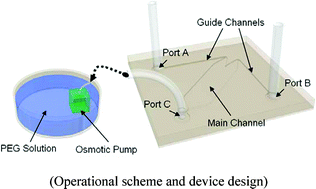Gradient generation by an osmotic pump and the behavior of human mesenchymal stem cells under the fetal bovine serum concentration gradient†
Abstract
This paper describes a method to generate a concentration gradient using an osmosis-driven pump, without the need for bulky peripheral devices, such as an electric syringe pump or a pneumatic pump. By the osmosis, the flow in the microfluidic channel can be controlled even to a very slow speed (nanolitre scale), which enables its application to generate the stable and wide (width = 4 mm) concentration gradient profile, even within a short flow path. A computational simulation was also performed to predict the local distribution of the solute concentration and velocity-pressure profile in the microfluidic chip. The performance of the osmosis-driven pump was evaluated by culturing human mesenchymal stem cells within the concentration gradient of fetal bovine serum. The effects of the gradient on attachment, viability and morphology of the cells were analyzed and quantified. The cell density in a higher serum concentration region was twice greater than that in the pure culture media. The compact, cost-effective, self-powered and osmosis-based gradient generation system can be useful for biomedical and chemical applications.


 Please wait while we load your content...
Please wait while we load your content...